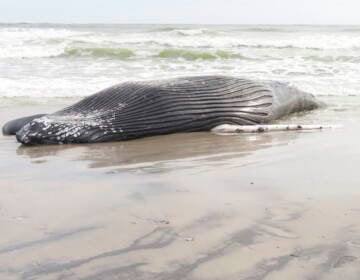N.J. crossing guards protect amphibians making deadly trek for love
The Sourland Conservancy has operated an amphibian crossing guard program for five years — with a focus on the spotted salamander.
Listen 3:49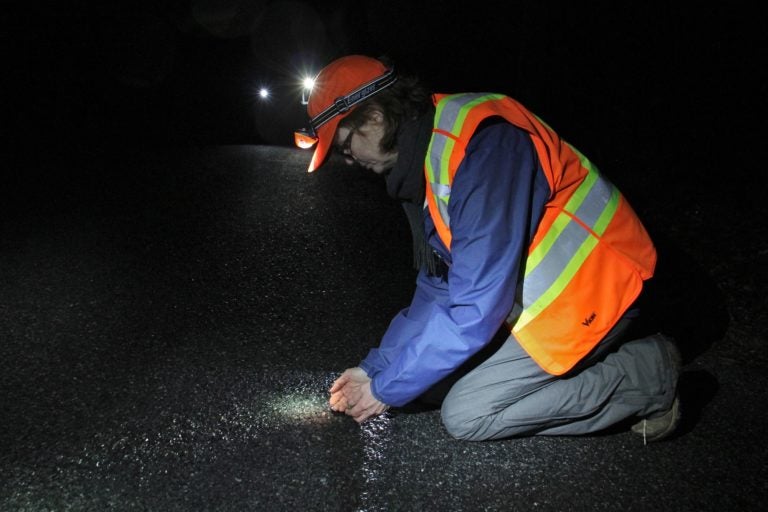
Laurie Cleveland of the Sourland Conservancy scoops up a wood frog to help it across the road, while volunteers with headlamps and flashlights patrol try to save the amphibians from being crushed by passing cars. (Emma Lee/WHYY)
Similar to the classic video game “Frogger,” hundreds of wood frogs and yellow spotted salamanders north of Hopewell, New Jersey are about to face seemingly insurmountable obstacles – cars.
But this time, the goal is to find a mate.
The amphibians need to go from their hibernation spots to the shallow, seasonal pools where they were born in — vernal pools — to mate. Humans have made that trek harder by building roads that often get in the way.
“You see the carnage of what happens when these amphibians are trying to move [across the road],” said Bill Bausmith, who over the past 26 years has witnessed hundreds of amphibians get crushed on the country road next to his house, which is near a popular mating spot. “You see [the carnage] as you walk your dogs, as you take your bike ride as you walk as we do on this road every day.”
But these amphibians will have some unlikely sidekicks when they awaken from their winter slumber and begin their Herculean love journey this year — faux traffic cops.
Amphibian crossing guard programs have cropped up along the East Coast over the years — including Virginia, Pennsylvania, Massachusetts, and Maine — as guerilla efforts to protect the critters during their great migration.
With the help of the Mercer County Park Commission, the Sourland Conservancy has operated an Amphibian Crossing Guard program for five years.
Despite the program’s name, which suggests a lot of amphibian handling, it’s preferred volunteers do not touch the slimy creatures – it stresses the critters out and could disorient them — unless it’s absolutely necessary.
The other primary goal is to get better counts of the amphibian population.

“Hopefully we can learn a little bit about them and perhaps one day even put in some kind of crossing under the road so we won’t have to do this any longer,” said Laurie Cleveland, executive director of the Sourland Conservancy.
Still, there are only so many guards to place on the deadliest roads, so the crossing data they collect has its limits. The volunteers have to track everything from the number of amphibians that cross, to the amount of precipitation and humidity at the time of the crossing.
In 2019, the group crossed 850 amphibians and recorded 260 DORs (dead on road) across eight sites where they assigned guards.
“This isn’t like super scientifically rigorous, it’s not like university publication level,” said Alex Rivera, a land steward with the Mercer County Park Commission. “It’s data that we’re collecting to make informed decisions quickly. We don’t have to have these long-lasting studies to make land management decisions.”
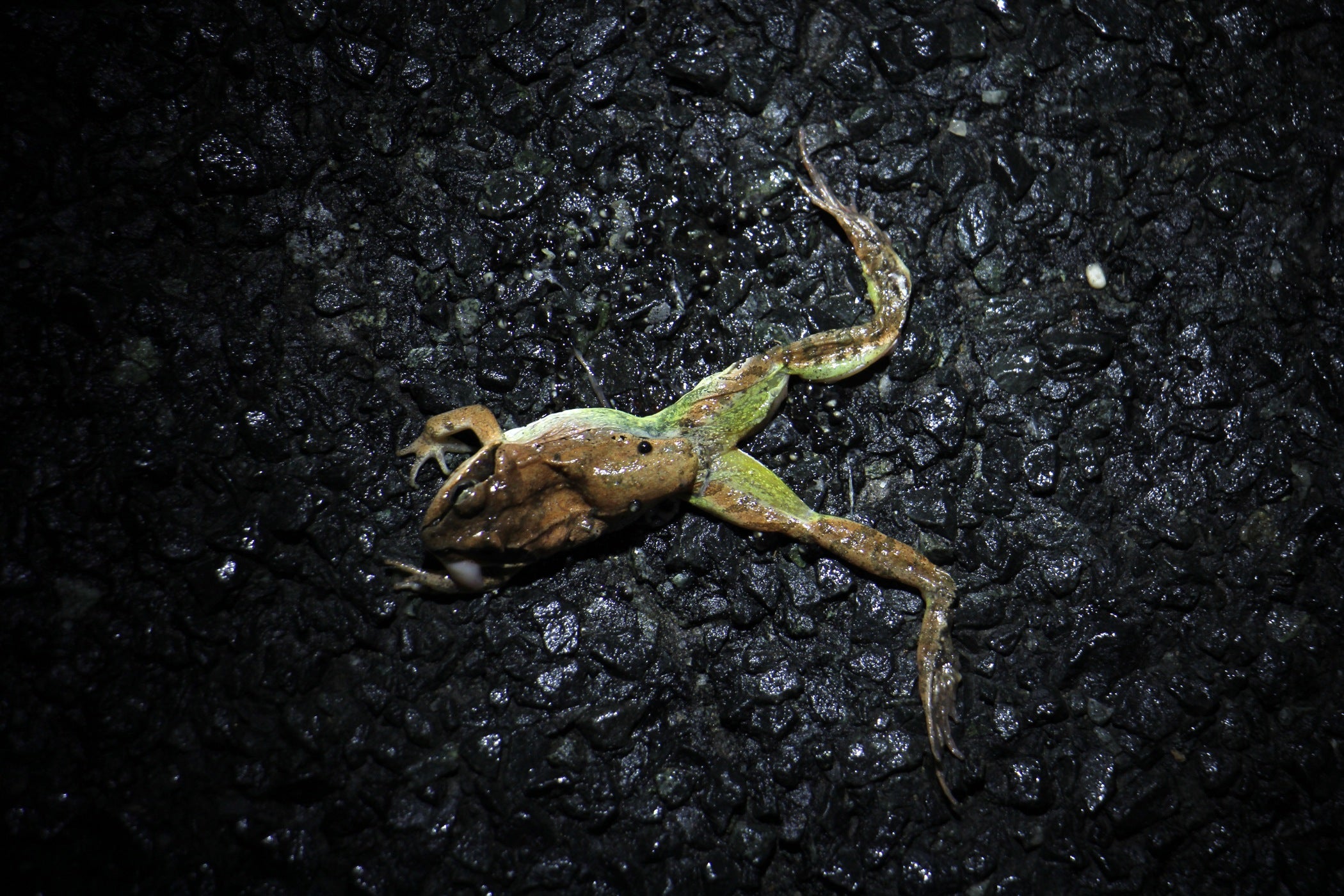
Rivera, who helped run a mandatory, once-a-year training for some 50 wannabe volunteers this January, added the data collection also makes for grueling work.
“It’s going to be raining. It’s going to be wet. You’re going to be uncomfortable if you’re not wearing your crew gear,” Rivera told trainees in January. “The temperatures that this is going to happen at — 40, 45 degrees — that might be a little bit warm to an amphibian, but that’s cold for us.”
Waiting for the call
Crossing guards are not unlike Bruce Wayne in the sense they could get the signal mobilizing them onto roads any day, with less than 24 hours’ notice.
In past years, Rivera and Cleveland could tell crossing guards to expect salamanders and wood frogs to wake up from their winter slumber at the tail end of March and the beginning of April.
But unpredictable weather attributed to climate change has widened that window. It’s not unusual to have a phone tree activation go off in the first week of February, like it did this year, only to be deemed a false alarm the next day.
“It seems that the salamanders may have hit the snooze alarm…” wrote Cleveland, ending her email with her signature frog emoji.
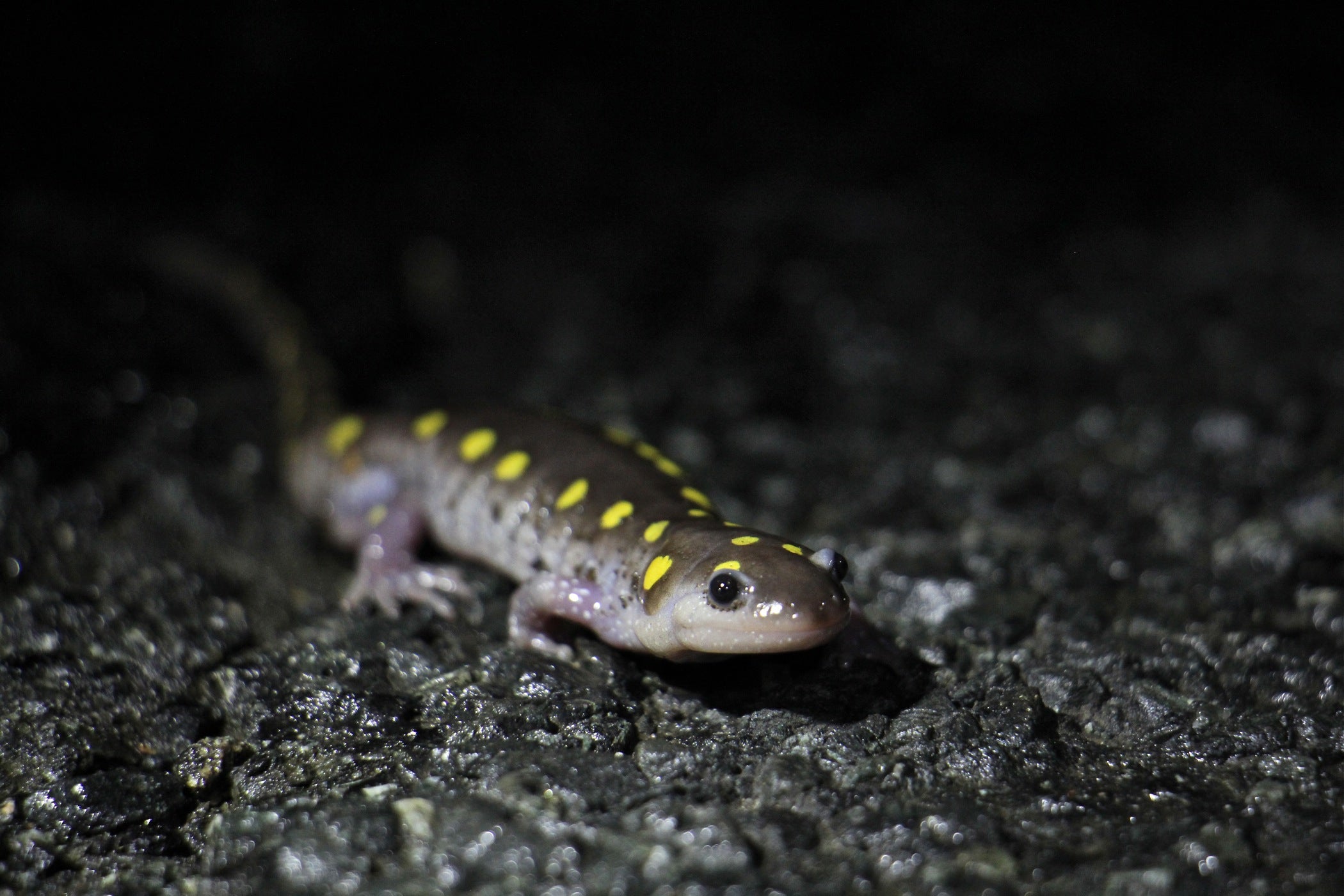
The only thing that’s certain for crossing guards is that whatever day they’re called to action, they’ll be crossing amphibians between 7 and 9 p.m. — when cars are likely to be on the road.
This year, the real mobilization came the last week of February with a forecast in the 40s and more than 55% chance of precipitation. Residents like Bausmith also reported groggy salamanders approaching his road.
Friends Sharon Hallanan, a lawyer from Lambertville, and Rene Lawless, an educational researcher in Hopewell, have answered the call for the second and third year in a row, respectively.
The women dusted off their rain gear, grabbed some orange vests and headlamps, and joined a handful of other guards ready to count amphibians.
“I think it’s important to save the littlest creatures possible because they’re part of our ecosystem, they’re sort of a gauge of how the environment is doing in terms of toxins and clean water,” Lawless said.

The sentiment was echoed by the crew that included a college biology major, an engineer, an IT worker, who together broke up a mile of road into 200-meter stretches.
Pairs walked the same stretch of road over and over for hours, keeping their headlamps on a swivel to avoid stepping on a crawler, tally crossers, or scrape a DOR (dead on road).
Every half hour, guards paused to jot down the weather conditions and restart the tally in a new column. The drizzle made for a relatively slow shift, with only a handful of amphibians crossing every 30 minutes. When it’s pouring, volunteers say it’s hard to walk without stepping on a spring peeper or salamander.

Whenever vehicle lights began to pierce the dark road, volunteers shouted “car!”
Prompting volunteers to quickly scoop amphibians out of the vehicle’s path.
Most drivers would slow down once they noticed the neon vested volunteers darting across the road. Some motorists even stopped to ask the guards what they were up to. But a handful of drivers kept their speed at a steady 40 miles an hour.
“I can’t stress enough that your safety is more important than the safety of the critters,” Cleveland told guards. “Because if you’re injured, think about it, you won’t be able to help any others…Sometimes you just gotta let them go.”
Still, aggressive drivers are not enough to scare away volunteers.
“I never had the opportunity to see salamanders or frogs when I was growing up in the middle of suburbia [in Ewing] so it’s kind of fun to see what’s in your backyard,” said Lawless, who saw her first spotted salamander this February after being a crossing guard for three years.
The team aims to protect all amphibians but places a special focus on the 6-to-9-inch long spotted salamander, which can have a harder time avoiding speeding cars.
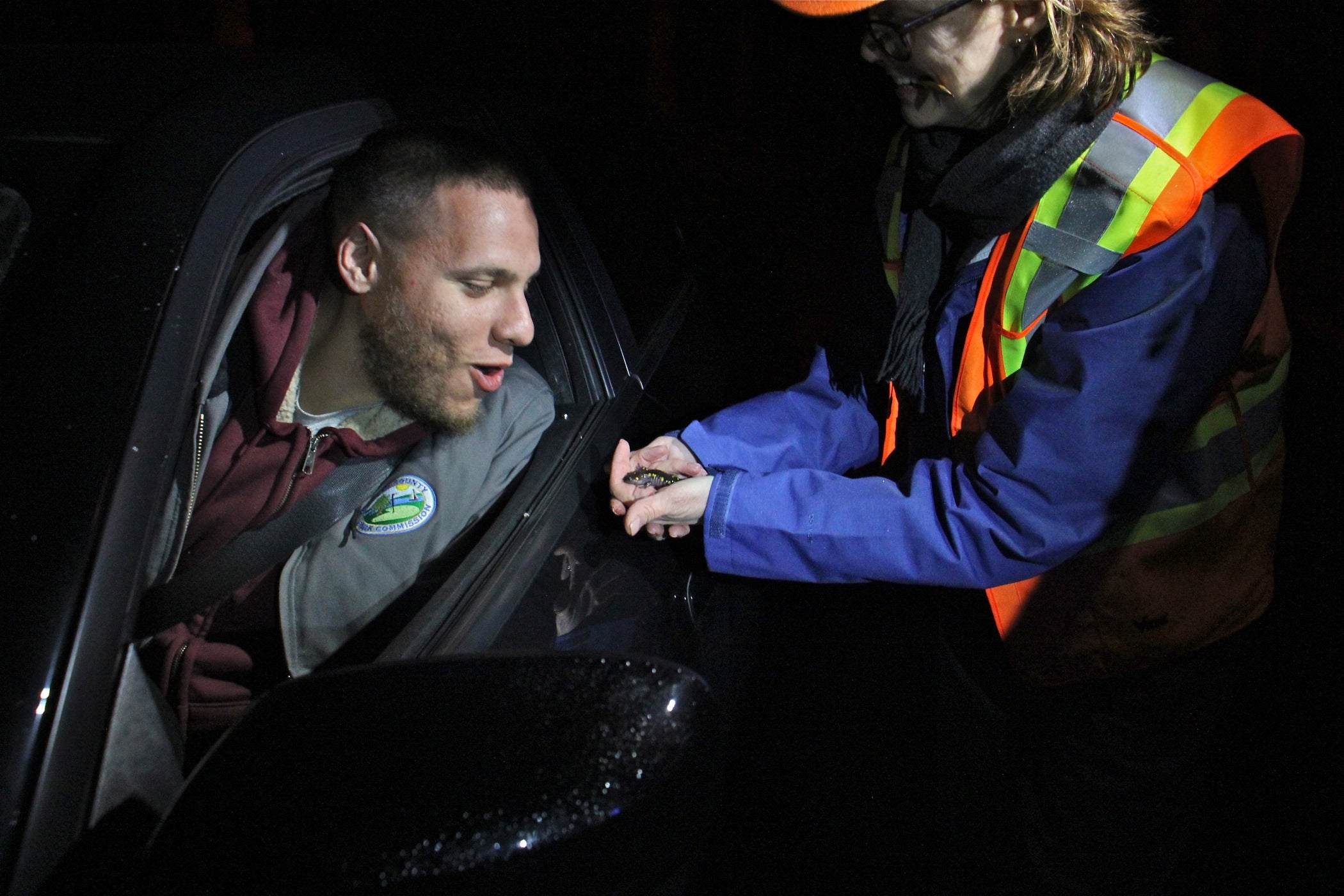
Though the spotted salamander is not at risk for extinction in New Jersey or nationwide, a near local extinction in some vernal pools has been enough to spring more and more residents into action in recent years. Conservationists in Mercer and Hunterdon counties welcome the salamanders and other amphibians as mosquito control and value them as a sign of healthy ecosystems.
The guards acknowledge it may seem eccentric to go through all that trouble to save fewer than 1,000 amphibians, but it’s worth it to hear the loud chorus of quacks they hear on the other side of the road.
That’s hundreds of wood frogs who have made it to their vernal pool successfully, presumably with the quieter yellow-spotted salamanders not far behind.
The quacks are the frogs getting their steamy, Hollywood rom-com ending.
Now, as Cleveland likes to say when the frogs pair up: “A little privacy please.”
WHYY is your source for fact-based, in-depth journalism and information. As a nonprofit organization, we rely on financial support from readers like you. Please give today.


